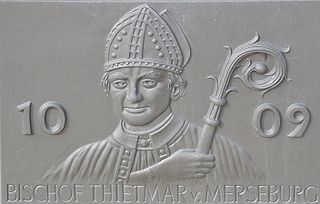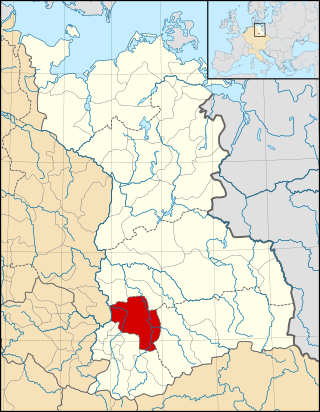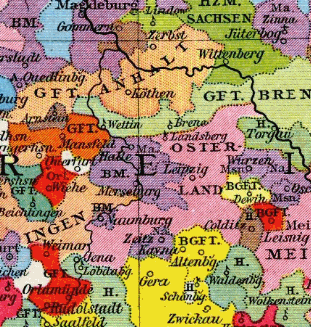
Adalbert of Magdeburg, sometimes incorrectly shortened to "Albert", known as the Apostle of the Slavs, was the first Archbishop of Magdeburg and a successful missionary to the Polabian Slavs to the east of what was contemporarily Germany. He was later canonised and his liturgical feast day was assigned as 20 June.

The Archbishopric of Magdeburg was a Latin Catholic archdiocese (969–1552) and Prince-Archbishopric (1180–1680) of the Holy Roman Empire centered on the city of Magdeburg on the Elbe River.

The Northern March or North March was created out of the division of the vast Marca Geronis in 965. It initially comprised the northern third of the Marca and was part of the territorial organisation of areas conquered from the Wends. A Lutician rebellion in 983 reversed German control over the region until the establishment of the March of Brandenburg by Albert the Bear in the 12th century.

Thietmar, Prince-Bishop of Merseburg from 1009 until his death in 1018, was an important chronicler recording the reigns of German kings and Holy Roman Emperors of the Ottonian (Saxon) dynasty. Two of Thietmar's great-grandfathers, both referred to as Liuthar, were the Saxon nobles Lothar II, Count of Stade, and Lothar I, Count of Walbeck. They were both killed fighting the Slavs at the Battle of Lenzen.

Benno was named Bishop of Meissen in 1066. Venerated since the 13th century, he was canonized in 1523. Benno did much for his diocese, both by ecclesiastical reforms on the Hildebrandine model and by material developments. He was venerated in his native Saxony throughout the Late Middle Ages.

The Margravate or Margraviate of Meissen was a medieval principality in the area of the modern German state of Saxony. It originally was a frontier march of the Holy Roman Empire, created out of the vast Marca Geronis in 965. Under the rule of the Wettin dynasty, the margravate finally merged with the former Duchy of Saxe-Wittenberg into the Saxon Electorate by 1423.
Rikdag, also called Ricdag, Riddag, or Rihdag, was Margrave of Meissen from 979 until his death. In 982, he also acquired the marches of Merseburg and Zeitz. After the Great Slav Rising in 983, he temporarily reunited all of the southern marca Geronis under his command. His march included the territory of the Chutizi and Dolomici tribes.

The Diocese of Dresden–Meissen is a Latin Church diocese of Catholic Church in Germany with its seat in Dresden. It is suffragan to the Archdiocese of Berlin.

Naumburg Cathedral, located in Naumburg, Germany, is the former cathedral of the Bishopric of Naumburg-Zeitz. The church building, most of which dates back to the 13th century, is a renowned landmark of the German late Romanesque and was recognised as a UNESCO World Heritage Site in 2018. The west choir with the famous donor portrait statues of the twelve cathedral founders (Stifterfiguren) and the Lettner, works of the Naumburg Master, is one of the most significant early Gothic monuments.

The Bishopric of Merseburg was an episcopal see on the eastern border of the medieval Duchy of Saxony with its centre in Merseburg, where Merseburg Cathedral was constructed. The see was founded in 967 by Emperor Otto I at the same time in the same manner as those of Meissen and Zeitz, all suffragan dioceses of the Archbishopric of Magdeburg as part of a plan to bind the adjacent Slavic ("Wendish") lands in the Saxon Eastern March beyond the Saale River more closely to the Holy Roman Empire.

The March of Merseburg was a short-lived march of the Holy Roman Empire. It comprised the lands of the Polabian Slavs beyond the margravial residence at Merseburg on the Saale river.

Eckard I was Margrave of Meissen from 985 until his death. He was the first margrave of the Ekkehardinger family that ruled over Meissen until the extinction of the line in 1046.
Gisilher, Gisiler or Giseler was the second Archbishop of Magdeburg, succeeding Saint Adalbert, from 981 until his death in 1004.
Gunther was the Margrave of Merseburg from 965 until his death, upon which the march of Merseburg was united to that of Meissen.

The Diocese of Görlitz is a Latin Church diocese of the Catholic church in Germany. The current ordinary is Wolfgang Ipolt
Dedo I, Count of Wettin, also known as Dedo I of Wettin, was a son of Theodoric I of Wettin and Jutta of Merseburg.

Henry II, also known as Saint Henry the Exuberant, Obl. S. B., was Holy Roman Emperor from 1014. He died without an heir in 1024, and was the last ruler of the Ottonian line. As Duke of Bavaria, appointed in 995, Henry became King of the Romans following the sudden death of his second cousin, Emperor Otto III in 1002, was made King of Italy in 1004, and crowned emperor by Pope Benedict VIII in 1014.

In the Slavic revolt of 983, Polabian Slavs, Wends, Lutici and Obotrite tribes, that lived east of the Elbe River in modern north-east Germany overthrew an assumed Ottonian rule over the Slavic lands and rejected Christianization under Emperor Otto I.

The Prince-Bishopric of Naumburg-Zeitz was a medieval diocese in the central German area between Leipzig in the east and Erfurt in the west. The seat of the bishop was Zeitz Cathedral in Zeitz from 968 and 1029 and Naumburg Cathedral in Naumburg between 1029 and 1615. It was dissolved in the wake of the Reformation. The Bishopric of Zeitz-Naumburg encompassed the four archdeaconries of Naumburg, Zeitz, Altenburg and "trans Muldam".
Eido I, also Ido, Eid or Ägidius, was the bishop of Meissen from 992 to 1015.












